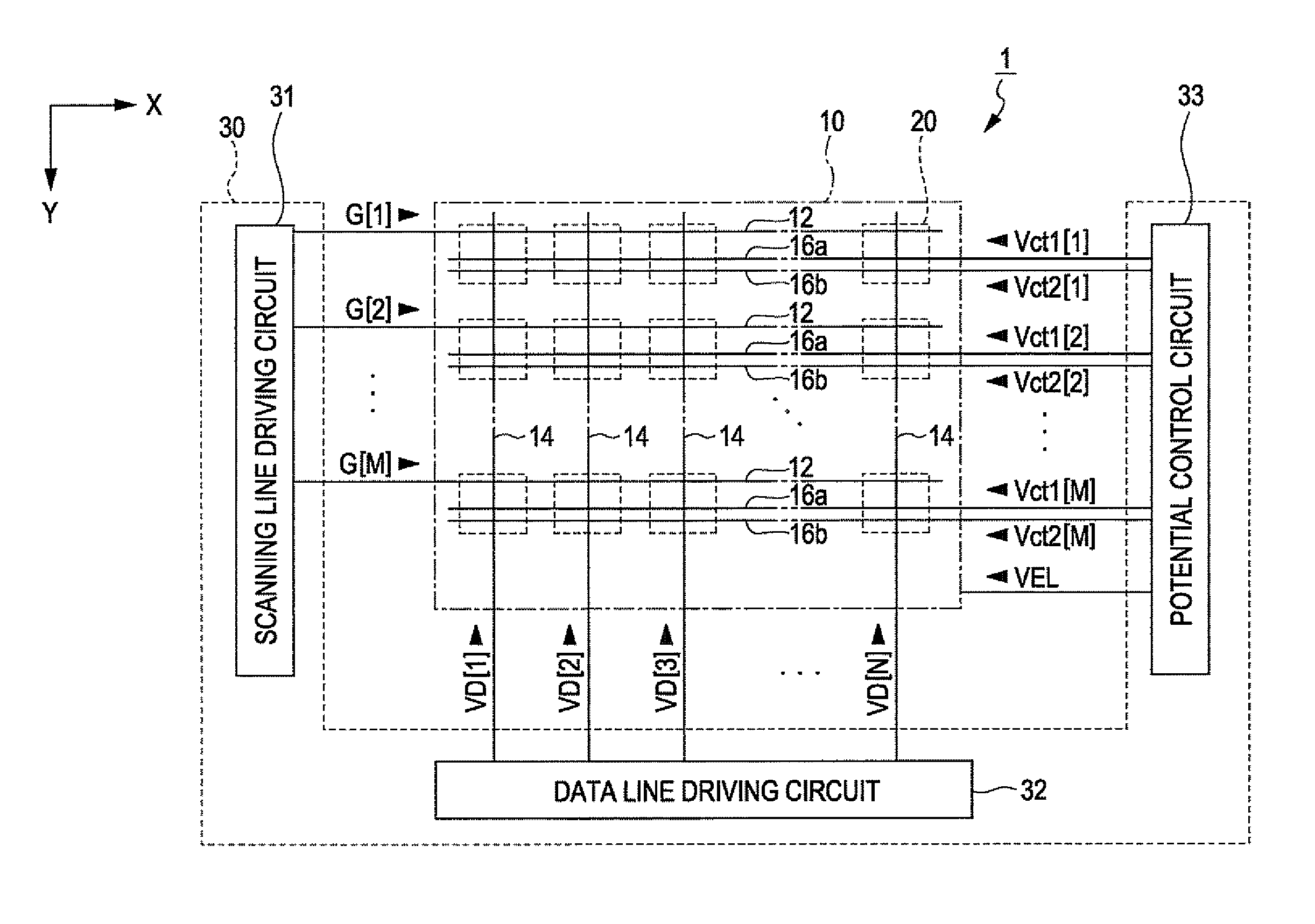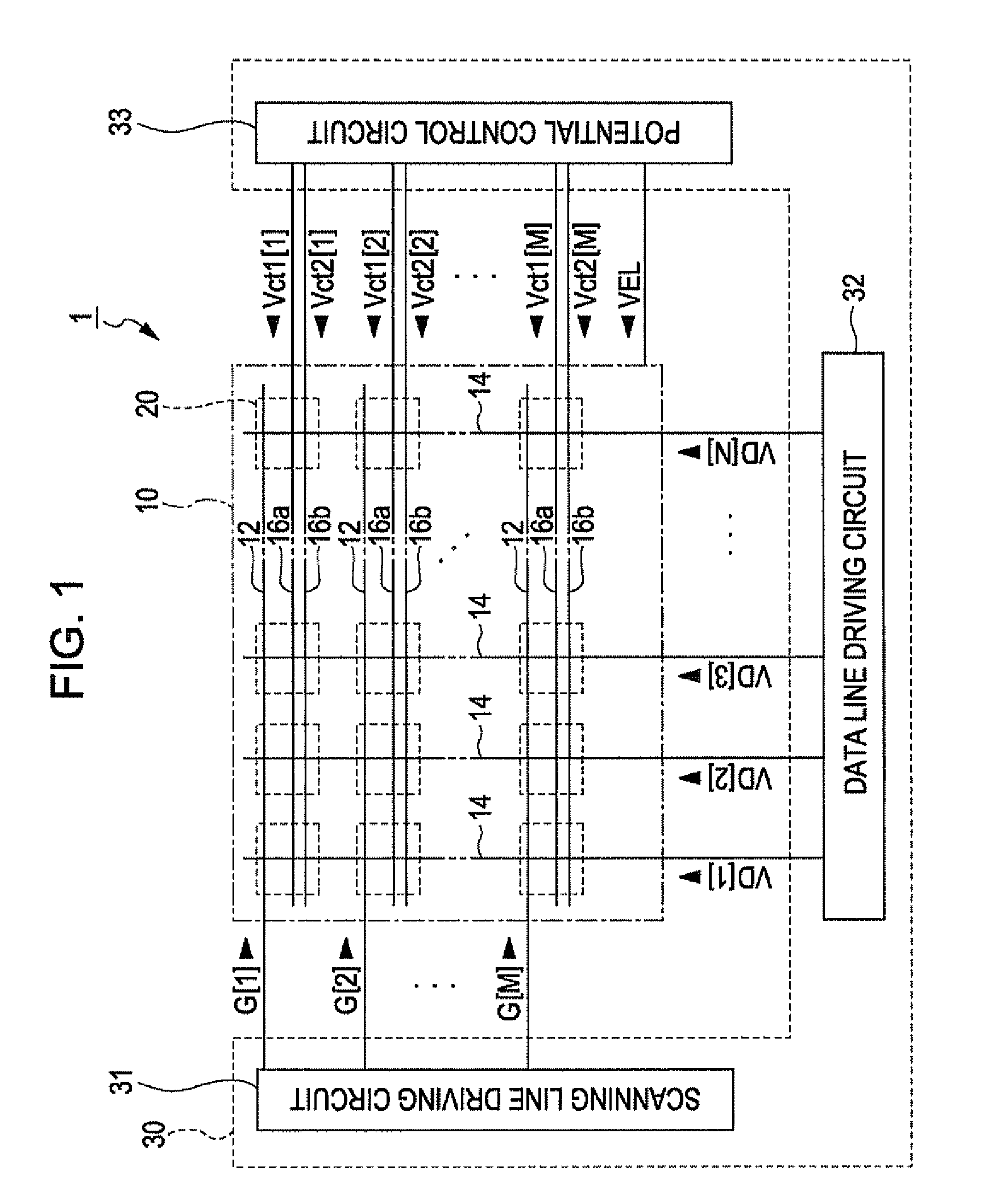Pixel circuit, driving method thereof, electro-optical apparatus and electronic device
- Summary
- Abstract
- Description
- Claims
- Application Information
AI Technical Summary
Benefits of technology
Problems solved by technology
Method used
Image
Examples
first embodiment
A: First Embodiment
[0047]Hereinafter, various embodiments of the invention will be described with reference to the accompanying drawings. In the drawings, the dimensions and ratios of each component are suitably changed from actual ones.
[0048]FIG. 1 is a block diagram showing a display device 1 according to the first embodiment of the invention. The display device 1 includes a display region 10 in which a plurality of pixel circuits 20 are arranged, and a driving circuit 30 for driving each pixel circuit 20. The driving circuits 30 are distributed and mounted to, for example, a plurality of integrated circuits. However, at least a part of the driving circuits 30 may be configured as a thin film transistor formed on a substrate together with the pixel circuit 20.
[0049]In the display region 10, M number of scanning lines 12 extending in an X direction, M number of first power lines 16a and M number of second power lines 16b extending in the X direction, and N number of data lines 14 e...
second embodiment
B: Second Embodiment
[0110]The display device according to the first embodiment is configured so that the first power potential Vct1[i] is the fixed potential Vcst and the second power potential Vct2[i] has a lamp waveform, whereby the first light emitting element E1 emits light and the second light emitting element E2 does not emit light. In contrast to this, the display device according to the second embodiment is different from the display device of the first embodiment in the points that the first power potential Vct1[i] is any one of the fixed potential Vcst and the lamp waveform and the second power potential Vct2[i] is the other, and that the one and the other take turns at every one vertical scanning period.
[0111]The display device of the second embodiment is configured identically to the display device 1 of the first embodiment, except that the first power potential Vct1[i] and the second power potential Vct2[i] generated by the potential control circuit 33 have different wa...
third embodiment
C: Third Embodiment
[0124]FIG. 12 is a timing chart for illustrating operations of a display device according to a third embodiment.
[0125]The display device of the third embodiment is configured identical to the display device 1 of the first embodiment, except that the first power potential Vct1[i] and the second power potential Vct2[i] generated by the potential control circuit 33 have different waveforms.
[0126]In other words, in the first embodiment, the second power potential Vct2[i] has a lamp waveform varying between the first potential VL and the second potential VH, and the first power potential Vct1[i] is maintained at the fixed potential Vcst. In this regard, in the third embodiment, the first power potential Vct1[i] and the second power potential Vct2[i] are output from the potential control circuit 33 so as to have a waveform periodically varying between the first potential VL and the second potential VH.
[0127]As shown in FIG. 12, in the period when the selection signal G[...
PUM
 Login to View More
Login to View More Abstract
Description
Claims
Application Information
 Login to View More
Login to View More - R&D
- Intellectual Property
- Life Sciences
- Materials
- Tech Scout
- Unparalleled Data Quality
- Higher Quality Content
- 60% Fewer Hallucinations
Browse by: Latest US Patents, China's latest patents, Technical Efficacy Thesaurus, Application Domain, Technology Topic, Popular Technical Reports.
© 2025 PatSnap. All rights reserved.Legal|Privacy policy|Modern Slavery Act Transparency Statement|Sitemap|About US| Contact US: help@patsnap.com



